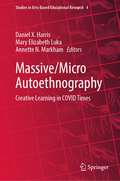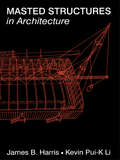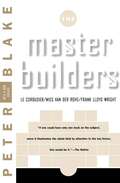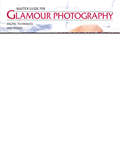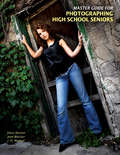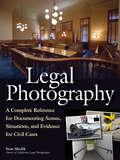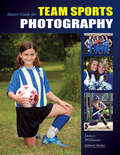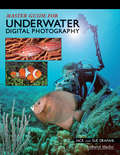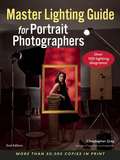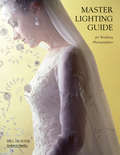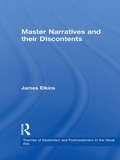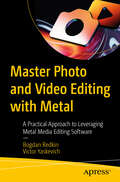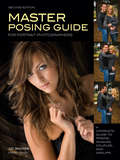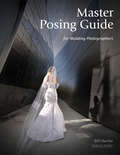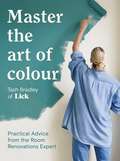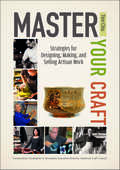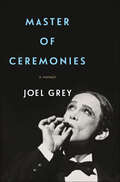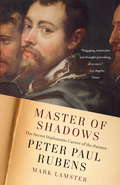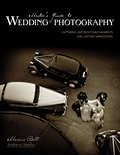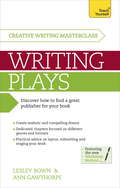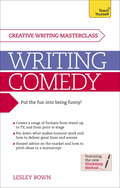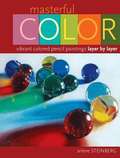- Table View
- List View
Massive/Micro Autoethnography: Creative Learning in COVID Times (Studies in Arts-Based Educational Research #4)
by Daniel X. Harris Mary Elizabeth Luka Annette N. MarkhamThis book presents the creative, arts-based and educative thinking resulting from a “21 day autoethnography challenge” set of self-guided prompts arising from the large-scale collaborative, creative, and global project to explore Massive and Microscopic Sensemaking during COVId-19 Times. It employs a guiding methodological framework of critical autoethnography, narrating the macro and micro experiences of COVID-19 from a first-person, and critically, culturally-informed perspective. The book features chapters creatively responding to the 21-day pandemic experiment through digital autoethnographic artworks, writings, and collaborations. It allowed authors to build embodied sensibilities, practice autoethnographic forms of writing and making, and transform personal experiences through the COVID-19 moment into critical understanding of scale, sense-making, and the relationality of humans, nonhumans, and the planet.
Masted Structures in Architecture
by James Harris Kevin LiThis is the first fully comprehensive survey and analysis of masted structures and covers examples that have evolved during the past three decades.Masted Structures are one of the most interesting developments in post-war architecture resulting from a combination of technology, structural engineering theory and a collaboration between architects and engineers. This is an essential guide for architects to the structural and constructional implications of masted forms in relation to space enclosure, patterns of loading and use of differing materials and techniques. This useful volume will enable architects and engineers to understand the origins, development and nature of masted structures and will provide a stimulating basis for future design.
Master Builders: Le Corbusier, Mies Van Der Rohe, And Frank Lloyd Wright
by Peter BlakeThe story of modern architecture is told here through the lives and works of three men who changed the face of the cities we live in. Le Corbusier gave to modern design a sure and brilliant sense of form; Mies brought an almost Gothic discipline of structure; and Wright heralded a new and dramatic concept of space and freedom. Through this triple focus, Peter Blake provides a perspective on the entire range of twentieth-century architecture. 129 photographs and 22 drawings
Master Guide for Glamour Photography: Digital Techniques and Images
by Chris NelsonThis guidebook to nude and beauty photography provides amateurs and professionals alike with the necessary tools to create tasteful and artistic images that exceed expectations. With tried-and-true, expert guidance, the entire photo-shoot process#151;from developing the desired style and look to digital post-production techniques#151;is explained Tips on posing and lighting, styling hair and makeup, and establishing a rapport with the subject, as well as chapters on creating smart marketing strategies, building a client base, and maximizing referrals to creating eye-catching displays and websites, are also included.
Master Guide for Photographing High School Seniors
by Dave WackerIn this instructive resource, seasoned photographers illustrate how to become an elite senior-portrait photographer. Whether the student wants a simple headshot for the yearbook, classic studio portraits, or fashion-oriented images shot on location, this resource outlines every phase of the process#151;from selecting the right equipment, poses, and light to generating great expressions and using the computer to retouch the face. An emphasis to stay ahead of the competition in terms of style, technology, customer service, and advertising offers photographers no-nonsense ideas for shooting better images and providing more variety within the often very limited time constraints of a senior-portrait session. Packed with before-and-after images, sequential illustrations that show posing variations, sample marketing materials, and much more, this is a must have book for those entering the market#151;or those seeking to chisel out a bigger share.
Master Guide for Professional Photographers
by Patrick RiceFrom shooting basics to image editing, this textbook is an all encompassing reference that can be used by students in any level of photography class as well as those studying to complete the Certified Professional Photographer program. Beginning with an overview of camera choices and basic camera functions, this guide outlines the fundamentals of lighting equipment, light theory, composition, and digital imaging while providing a comprehensive roadmap for efficiently taking images from conception to client presentation. Tips for overcoming obstacles are offered from the hard-won advice of photographers who have successfully passed the Professional Photographer Certification Program tests.
Master Guide for Team Sports Photography
by James WilliamsA comprehensive look at all aspects of photographing sports teams-from selecting and using equipment to processing and presenting the images while building a client base-this reference proves indispensable to any photographer looking to expand their repertoire or branch out into a new profession. Professional guidance covers topics ranging from working with school administrations and coaches to the keys to capturing subjects in motion. Chapters on creating attractive, salable group packages and forming a distinctive business plan are also included.
Master Guide for Underwater Digital Photography
by Sue Drafahl Jack DrafahlFrom camera selection to enhanced exposure, everything necessary to capture underwater digital images is available in this handy reference. Photographers will learn how to select, test, and use digital cameras for technically perfect images, adapt traditional photo techniques to underwater conditions, confidently shoot and light underwater images for great exposure, and remedy common problems that plague underwater photographers. Helpful hints on maintaining, cleaning, transporting, and insuring a digital camera are included. With full-color images that both instruct and inspire, this handbook provides information on every conceivable aspect of creating the right conditions for beautiful underwater photographs.
Master Lighting Guide for Portrait Photographers
by Christopher GreyLight is the photographer's strongest ally in creating evocative portraits. With the right lighting application, photographers can highlight subjects' assets, downplay flaws, create mood, and even tell a story about the subject.In Master Lighting Guide, Christopher Grey presents a classroom-in-a-book approach to lighting techniques. First, readers will learn about the characteristics of light. Next, Grey introduces photographers to light positions and functions, providing the information needed to make solid decisions about the kind of light they will need to create sculpted, flattering portraits. Moving on to lighting patterns, Grey shows how to create desirable highlights and shadows that sculpt the subjects features and set the stage for stunning results.With a clear understanding of the essentials of portrait lighting, readers will progress through more specific lighting applications. Grey shows how to light portraits for business, how to create editorial portraits (photos to be used in magazines or simply for clients who favor that look), model/actor portraits, and even intimate portraits. He shows how to use specialized lighting approaches like high- and low-key lighting, flare, and intentional overexposure to create mood in your images.Two of the biggest strengths of Grey's acclaimed instructional approach are (1) the progressive images that show the changes that occur when light positions and intensities are altered and (2) the numerous diagrams presented that show readers how to position their lights and modifiers to mimic Grey's results. These approaches, paired with Grey's technical precision and creative vision, make this book a perennial favorite and a resource that photographers will turn to time and again for inspiration and technical prowess.
Master Lighting Guide for Portrait Photographers
by Christopher GreyLight, vibrant and malleable, is the greatest tool at the disposal of portrait photographers. In this acclaimed book--with over 50,000 copies in print--Christopher Grey walks you through studio portrait lighting from start to finish. Dozens of image sequences and before/after pairings show you precisely how each change of light position and modifier affects the look of the lighting on the subject. From classic portrait lighting patterns to unexpected but powerful looks, Grey teaches you everything you need to know to control light effectively. Armed with these powerful skills, you'll be able to create portraits that are more flattering, more marketable, and more creative.y for clients who favor that look), model/actor portraits, and even intimate portraits. He shows how to use specialized lighting approaches like high- and low-key lighting, flare, and intentional overexposure to create mood in your images.Two of the biggest strengths of Grey's acclaimed instructional approach are (1) the progressive images that show the changes that occur when light positions and intensities are altered and (2) the numerous diagrams presented that show readers how to position their lights and modifiers to mimic Grey's results. These approaches, paired with Grey's technical precision and creative vision, make this book a perennial favorite and a resource that photographers will turn to time and again for inspiration and technical prowess.
Master Lighting Guide for Wedding Photographers
by Bill HurterMaster the demanding lighting needs for weddings of any variety with this comprehensive guide from an industry expert. All the basics are covered, including how to choose and use the right equipment, how to control light and shadow while outdoors, how to utilize ambient room light and natural light, and how to ensure the best color balance for each image. Technical tips from 40 top wedding photographers cover such specifics as producing window-light images and using such tools as scrims, umbrellas, and gobos. With the right lighting know-how, a photographer can capture with ease the candid looks and pure emotions of the wedding party.
Master Low Light Photography: Create Beautiful Images From Twilight To Dawn
by Heather HummelMost photographers shoot in abundant sunlight. The problem is, full sun creates harsh, unflattering shadows that undermine images. Working in low light -- in early morning or at twilight or when Mother Nature cues the clouds or fans in the fog -- can help photographers produce stand-out images. Photographers will learn to analyze light and determine the best camera settings for creating captivating low-light images outdoors. Composition--the artful arrangement of all of the image elements -- is detailed next. From there, Hummel provides text and illustrations to guide readers through the art of producing low-light images of sunrises and sunsets; the moon and stars; hot air balloons, city lights, and fireworks; and nature and landscape photography. Hummel then moves on to discuss how photographers can use filters and camera-stabilizing tools to enhance the technical quality of their shots. Armed with the applications outlined in this book, photographers will be able to produce outstanding shots during off-peak hours.
Master Narratives and their Discontents (Theories of Modernism and Postmodernism in the Visual Arts #Vol. 1)
by James ElkinsIn this bracing engagement with the many versions of art history, James Elkins argues that the story of modernism and postmodernism is almost always told in terms of four narratives. Works of art are either seen as modern or postmodern, or praised for their technical skill or because of the politics they appear to embody. These are master narratives of contemporary criticism, and each leads to a different understanding of what art is and does. Both a cogent overview of the state of thinking about art and a challenge to think outside the art historical box, Master Narratives and their Discontents is the first volume in a series of short books on the theories of modernism by leading art historians on twentieth-century art and art criticism.
Master Photo and Video Editing with Metal: A Practical Approach to Leveraging Metal Media Editing Software
by Bogdan Redkin Victor YaskevichDelve into the nuances of photo and video editing with Metal, a framework from Next Generation GPU APIs. Right now, the demand for media editors is growing exponentially, with multiple applications needing some form of image processing, including messengers, social networks, marketplace, and banking applications. This book provides detailed guidelines for reimplementation instruments from one of the more popular photo and video editors. Begin your journey by reviewing the rationale for using Metal, and an overview of the reasons why this this is the best performance solution. Rasterization is then covered to provide a basis for understanding how image editing in Metal works. You’ll look at aspects of image processing such as rendering, image transformations, and working with textures. This knowledge then leads you to image editing, where it is applied to make basic color adjustments, shadows, blur, vignette, and color correction with LUT filters. These are fundamental aspects of any media editing software. Layers make up the final section of the book, including different compositions and blend modes, both essential tools for any image editor. You’ll conclude the journey with a look at video editing with Metal. Through hands-on projects in each chapter, you will learn how to apply these techniques directly in real-world scenarios, giving a great starting point to implement any kind of media processing in your own applications. What You Will Learn Understand fundamental concepts of GPU rendering to complex image and video processing techniques See how shaders are accessed in the rendering pipeline Create and import textures Review image and video editing techniques, from simple color adjustment to complex filters, layer composition, and real-time video effects Who This Book Is For Intermediate Swift developers interested in photo and video editing or diving deeper into understanding how GPU media processing works.
Master Plans and Encroachments: The Architecture of Informality in Islamabad (The City in the Twenty-First Century)
by Faiza MoatasimAmong urban designers and municipal officials, the term encroachment is defined as a deviation from the official master plan. But in cities today, such informal modifications to the urban fabric are deeply enmeshed with formal planning procedures. Master Plans and Encroachments examines informality in the high-modernist city of Islamabad as a strategic conformity to official schemes and regulations rather than as a deviation from them.For the new administrative capital of Pakistan designed in 1959 by Greek architect and planner Constantinos A. Doxiadis, Islamabad’s master plan offers a clear template of formal urban design within which informal spaces and processes have been articulated. Drawing on deep archival research, wide-ranging interviews, and an array of visual material, including photographs, maps, and architectural drawings, Faiza Moatasim shows how Islamabad’s master plan is not simply a blueprint that guides future urban development or makes its violations apparent; it is used by both city officials and citizens to develop informal spaces that accommodate unfulfilled needs and desires of those living and working in the city.Master Plans and Encroachments is the first book that examines the informal practices of both the privileged and the underprivileged. The book highlights how low-, middle-, and upper-income people do not randomly build informal spaces; they strategically use architectural techniques to support their informal claims to space, which are often met with the government’s tacit approval. By focusing on those spaces in Islamabad’s urban fabric that are not part of its official master plan, the book demonstrates how planning actually works in complex ways.
Master Posing Guide for Portrait Photographers
by J D WackerPhotographers are guided through every aspect of posing-beginning with the consultation and continuing with specific tips for posing children, high school seniors, wedding parties, families, events, teams, groups, and pets-in this comprehensive manual. Maintaining that good posing is 80 percent mental and only 20 percent technical, this guide stresses the importance of communication between photographer and subject to creating a portrait that not only captures the subject's personality but also makes the subject comfortable, fostering repeat business.
Master Posing Guide for Wedding Photographers
by Bill HurterOutlining a theory that combines the refinement of traditional posing techniques with the more organic, spontaneous techniques of photojournalism, this creative and informative resource offers poses that rely on personality and interaction. These instructions from a veteran wedding photographer provide the skills needed to recognize what makes a great pose and how to subtly direct your clients to achieve the needed balance between looking great and looking comfortable. Ultimately, this grouping of modern and traditional shots offers answers to the complications faced when attempting to pose wedding parties quickly while keeping the natural look that all wedding couples desire.
Master The Art Of Colour: Practical Advice from the Room Renovations Expert
by Tash BradleyThe ultimate guide to using colour in your home by a leading interiors expert. As Director of Interior Design at the Lick paint brand and a colour psychologist, Tash Bradley wants you to feel like she's sitting at your kitchen table guiding you to choose the colours that will both represent your style and have a positive impact on your space, whether you rent or own. Packed with practical tips and techniques, from colour theory and colour schemes to creating a flow from room to room, colour drenching, feature walls and painted ceilings, this is the ultimate guide to decorating in style. Including case studies of some of Tash’s favourite decorating projects, you can see her theory in practice, giving you a deeper understanding of how to make the right colour and styling choices. When it comes to designing a home, it's really important that you choose colours that you connect with; Master the Art of Colour will enable you to be creative and have fun, and give you the power to transform your home your way!
Master Your Craft: Strategies for Designing, Making, and Selling Artisan Work
by Tien ChiuDo you want to create unique, brilliantly designed works of craft? Make the most of your studio time? Develop your artistic "voice," skills, and career? Then this book is for you. Written by award-winning textile artist Tien Chiu, Master Your Craft: Strategies for Designing, Making, and Selling Artisan Work provides sharp insight into the creative process, from the first spark of inspiration to careful contemplation of the finished piece. Perspectives from 22 master artisans fuse with industrial product design techniques and the author's own craft experience to offer a powerful framework for designing, making, and selling your work. Master Your Craft outlines a powerful process for designing and creating beautiful work. It enables you to: Discover inspiration even in the most mundane things Brainstorm unique designs Refine your designs into visually powerful, useful work that is practical to make and sell Transform your creative process to work more enjoyably and effectively Take your design and construction skills to the next level Identify your distinctive personal style Create a career for yourself, either as an artist or an artisan. Packed with advice from master woodworkers, glass workers, ceramicists, textile artists, metalworkers, and more, Master Your Craftwill enable you to create stunning pieces and - if you choose - develop your craft into a career.
Master of Ceremonies: A Memoir
by Joel GreyJoel Grey, the Tony and Academy Award-winning Master of Ceremonies in Cabaret finally tells his remarkable life story. Born Joel David Katz to a wild and wooly Jewish American family in Cleveland, Ohio in 1932, Joel began his life in the theater at the age of 9, starting in children’s theater and then moving to the main stage. He was hooked, and his seven decades long career charts the evolution of American entertainment - from Vaudeville performances with his father, Mickey Katz to the seedy gangster filled nightclubs of the forties, the bright lights of Broadway and dizzying glamour of Hollywood, to juggernaut musicals like Cabaret, Chicago, and Wicked. Master of Ceremonies is a memoir of a life lived in and out of the limelight, but it is also the story of the man behind the stage makeup. Coming of age in a time when being yourself tended to be not only difficult but also dangerous, Joel has to act both on and off the stage. He spends his high school years sleeping with the girls-next-door while carrying on a scandalous affair with an older man. Romances with to-die-for Vegas Showgirls are balanced with late night liaisons with like-minded guys, until finally Joel falls in love and marries a talented and beautiful woman, starts a family, and has a pretty much picture perfect life. But 24 years later when the marriage dissolves, Joel has to once again find his place in a world that has radically changed. Drawing back the curtain on a career filled with show-stopping numbers, larger-than-life stars and even singing in the shower with Bjork, Master of Ceremonies is also a portrait of an artist coming to terms with his evolving identity. When an actor plays a character, he has to find out what makes them who they are; their needs, dreams, and fears. It’s a difficult thing to do, but sometimes the hardest role in an actor’s life is that of himself. Deftly capturing the joy of performing as well as the pain and secrets of an era we have only just started to leave behind, Joel’s story is one of love, loss, hard-won honesty, redemption, and success.
Master of Shadows: The Secret Diplomatic Career of the Painter Peter Paul Rubens
by Mark LamsterMaster of Shadows weaves a gripping drama of 17th-century cloak-and-dagger diplomacy with an insightful, authoritative exploration of Peter Paul Rubens' art and the private passions that influenced it.
Master's Guide to Wedding Photography
by Marcus BellFrom the history of photography and how to shoot wedding portraits to creating stylish albums and working with digital output, everything a wedding photographer needs to know is included in this all encompassing manual. Photographers are provided with a shooting guide that walks them through the wedding day and offers advice on a variety of topics-including integrating detail, capturing the walk down the aisle, working in and out of doors, and finding and illustrating key relationships. Traditional and "in" methods of wedding photography are depicted in an educational timeline that explores past, present, and future trends in the field; current photo manipulation software, such as Adobe Photoshop and compatible plugins, are also discussed. Emphasis is placed on client interaction both before and after the big day, transforming prints into fine arts products, and developing and fine tuning a creative shooting style.
Masterclass: How to create realistic and compelling drama and get your work performed
by Lesley Bown Ann Gawthorpe Lesley HudswellWriting Plays is the invaluable and comprehensive guide to anyone who wants to write plays and get them performed. It covers the basics of the theatre, creating and working with characters, writing realistic speech and dialogue, constructing compelling plots and creating a great ending. There are also separate chapters focused on writing for different genres, including pantomimes, musicals, radio and television. And a final section looks at the practicalities of laying out, submitting and staging your play.
Masterclass: Teach Yourself
by Lesley BownMasterclass: Write Great Comedy will reveal to both beginners and experienced writers the distinctive features that mark out comedy from other forms of creative writing. Having identified these, it will help you then to unlock your inner anarchist, and explore the different elements of comedy, using a combination of practical exercises, insight and creative inspiration. Whatever your preferred comic genre, you will find guidance on everything from wordplay and visual humour to plots, comedy characters and different styles. A section on performance will help you to hone stand-up skills, while chapters on stage and screen will give techniques and tips on how to craft a sitcom or create a sketch show. Finally, there is a uniquely frank but useful section on the realities of the markets, and the actualities of going it alone with self-publishing and self-promotion - or the tools you need to successfully pitch an idea or comic manuscript.
Masterful Color
by Arlene SteinbergVibrant Colored Pencil Paintings Layer by Layer Masterful Colorwill redefine the way you think about colored pencils. By employing such classic techniques as tonal underpainting, chiaroscuro and color layering, you will achieve a depth and intensity of color that rivals the celebrated paintings of the Old Masters. 15 step-by-step demonstrations teach a classic approach to color, value and composition features a gorgeous range of subject matter, from luscious fruits and flowers to shimmering porcelain, crystal, silver, glass and more all the lessons come together in a grand, start-to-finish painting demonstration, from initial concept to final touches. Ideal for artists at any stage of their colored pencil journey and applicable to any subject matter,Masterful Coloris the key to creating glowing paintings that stand the test of time.
